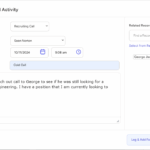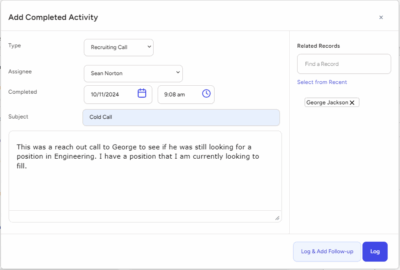In the fast-paced world of recruitment, where time is of the essence and talent is in high demand, finding the ideal candidate can be like searching for a needle in a haystack. Recruiters are constantly faced with the challenge of sifting through countless resumes, screening candidates, and ensuring a perfect match for their clients. That’s where an efficient and reliable candidate database for recruiters comes into play—a game-changer that can transform the way recruiters operate.
Top Echelon: a top candidate database for recruiters
Imagine having access to a comprehensive repository of qualified candidates, readily available at your fingertips. Picture a tool that not only simplifies the hiring process but also helps you identify the best talent swiftly, while minimizing effort and maximizing productivity. Enter Top Echelon Software—a leading candidate database solution designed to revolutionize the way recruiters source, connect, and hire top-tier professionals.
Why Top Echelon Software?
Top Echelon Software has earned its reputation as the go-to candidate database platform for recruiters worldwide. With its robust features and user-friendly interface, this software stands out from the competition, providing recruiters with an unmatched edge in their quest for exceptional talent:
#1—Extensive talent pool.
The backbone of any great candidate database is the quality and quantity of candidates it houses. Top Echelon Software boasts an extensive recruiting database for the members of its split placement network. That database is called the MEGA Database or the Network Candidates sourcing tool.
This database is meticulously curated to ensure that recruiters have access to a diverse range of skilled professionals across various industries and disciplines. From seasoned executives to fresh graduates, the platform offers a rich and diverse selection of candidates, catering to every recruitment need.
However, if you’re not a member of Top Echelon’s recruiting network, then you should have an extensive talent pool as part of your agency’s candidate database. And of course, Top Echelon Software offers an applicant tracking system that can house your candidate database, even if you’re not a member of Top Echelon’s network.
#2—Advanced search and filtering capabilities
The ability to narrow down search results based on specific criteria is crucial for recruiters. Top Echelon Software offers advanced search and filtering capabilities, allowing recruiters to quickly identify the most suitable candidates based on qualifications, experience, location, and other relevant parameters.
This streamlined approach saves time and effort, ensuring that recruiters can focus on building relationships with the most promising candidates.
#3—Seamless integration and workflow
Integration with existing recruitment tools and platforms is vital for a candidate database to be effective. Top Echelon Software seamlessly integrates with recruiting applications, email clients, and productivity tools, ensuring a seamless workflow for recruiters.
This integration eliminates the need for manual data entry, minimizing administrative tasks and maximizing efficiency.
So request your demo of Top Echelon Software today! Now, back to our regularly scheduled programming . . .
Streamline your candidate database management
Streamlining candidate database management is crucial for recruiters to effectively manage their talent pool and make the hiring process more efficient. A well-organized candidate database helps recruiters find the right candidates quickly, maintain clear communication, and build long-term relationships.
Listed below are 10 strategies to streamline candidate database management and optimize the recruitment workflow.
Implement a robust applicant tracking system (ATS): An ATS is a powerful tool that automates the entire recruitment process, from receiving applications to managing candidate profiles. It allows recruiters to store and organize candidate data in a centralized database, making it easier to search, sort, and track candidate information. Choose an ATS that fits your specific needs and ensures seamless integration with other recruitment tools.
Define standardized data entry processes: Establish clear guidelines for entering candidate data into the database. Create a template that includes essential information such as contact details, work history, skills, and qualifications. Encourage recruiters to follow the template consistently, ensuring uniformity and ease of searching for candidates based on specific criteria.
Categorize and tag candidates: Develop a standardized system for categorizing and tagging candidates based on their qualifications, skills, experience, and job preferences. This enables recruiters to quickly filter and find relevant candidates when new job openings arise. Use tags such as “technical skills,” “management experience,” or “preferred location” to streamline searches.
Regularly update candidate profiles: Encourage recruiters to regularly update candidate profiles with the latest information, including new qualifications, certifications, and work experiences. This ensures that the database remains accurate and up-to-date, saving time and effort in the future.
Automate resume parsing: Manual parsing of resumes is time-consuming and prone to errors. Invest in resume parsing technology that can automatically extract relevant information from resumes and populate the candidate profiles accurately. This saves recruiters significant time and ensures that no crucial information is missed.
Utilize keyword search functionality: An effective keyword search feature within your ATS allows recruiters to find candidates with specific skills, qualifications, or experience. Ensure that your database supports advanced search capabilities, such as Boolean operators, to refine searches and pinpoint the most suitable candidates quickly.
Maintain clear communication logs: Keep a record of all interactions with candidates, including emails, calls, and interview notes. This ensures that recruiters have easy access to previous conversations, making it easier to provide personalized and consistent communication throughout the hiring process.
Leverage automation for communication: Use automation tools to streamline communication with candidates, such as sending automated status updates, interview reminders, or rejection emails. This not only saves time but also ensures that candidates receive timely updates, enhancing their candidate experience.
Integrate with other recruitment tools: Look for opportunities to integrate your candidate database with other recruitment tools such as job boards, career sites, and assessment platforms. Integration allows for seamless data transfer, reducing manual data entry and increasing overall efficiency.
Regularly clean and de-duplicate the database: Over time, candidate databases can become cluttered with outdated or duplicate profiles. Implement regular cleaning and de-duplication processes to maintain data integrity. Remove duplicate entries, update expired profiles, and archive candidates who are no longer active.
Streamlining candidate database management is essential for recruiters to enhance their productivity and find the best talent efficiently. By implementing an ATS, defining standardized processes, utilizing automation tools, and regularly updating and cleaning the database, recruiters can streamline their candidate management processes, improve the overall recruitment workflow, and build strong relationships with candidates.
Top Tips to do Candidate Database Management Like a Professional
Effective candidate database management is a key aspect of being a recruiter. That could be an agency recruiter or a corporate recruiter.
However, database management involves more than just streamlining the process. It also requires a strategic approach to maximize the potential of your candidate database.
Below are 10 top tips to help you manage your candidate database like a professional:
#1—Segment your candidate database.
Categorizing your candidates into different segments can help you target specific groups more effectively. Consider creating segments based on job roles, industries, skills, or other relevant criteria.
This segmentation allows you to tailor your communication and outreach efforts, ensuring that you reach the right candidates with the right opportunities.
#2—Maintain a talent pipeline.
A talent pipeline refers to a pool of potential candidates who may not be immediately suitable for current openings but could be a good fit for future positions. Regularly review and update your talent pipeline by identifying and nurturing promising candidates.
Engage with them through personalized communication and keep them informed about upcoming opportunities. This proactive approach saves time in the future when new job openings arise.
#3—Implement candidate relationship management (CRM) strategies.
Building and nurturing relationships with candidates is crucial for successful recruitment. Use your candidate database as a CRM tool to track interactions, preferences, and key milestones in a candidate’s journey. Maintain regular communication, even if there isn’t an immediate job match.
This helps build rapport and increases the likelihood of successful placements in the future.
#4—Leverage data analytics.
Make use of data analytics to gain insights from your candidate database. Analyze metrics such as candidate sources, application-to-hire ratios, time-to-fill, and candidate quality. These analytics can help you identify trends, assess the effectiveness of your recruitment strategies, and make data-driven decisions to optimize your candidate database management.
#5—Utilize talent rediscovery.
As your candidate database grows, it’s common for qualified candidates to get buried in the system. Talent rediscovery tools or features within your ATS can help you uncover hidden gems in your database.
By leveraging AI and machine learning algorithms, these tools can analyze candidate profiles, job requirements, and historical data to identify potential matches that may have been overlooked.
#6—Embrace proactive sourcing.
Don’t solely rely on inbound applications to populate your candidate database. Actively seek out candidates through various sourcing channels like social media, networking events, industry forums, and professional associations.
Proactive sourcing allows you to tap into a wider pool of talent and ensures a constant influx of qualified candidates to enrich your database.
#7—Encourage employee referrals.
Employee referrals are an effective way to identify top-quality candidates. Establish a structured employee referral program that incentivizes employees to recommend qualified candidates.
When leveraging your candidate database, consider prioritizing referrals from current employees as they are more likely to be a cultural fit and have a higher chance of success.
#8—Develop a strong employer brand.
A strong employer brand attracts high-quality candidates and fosters long-term relationships. Invest in building a positive online presence, showcase your company culture, and highlight employee success stories. Promote your employer brand consistently through social media, career fairs, and industry events.
A strong employer brand not only enhances candidate engagement but also helps attract passive candidates to your database.
#9—Stay compliant with data protection regulations.
As a recruiter, it’s essential to adhere to data protection regulations, such as GDPR (General Data Protection Regulation) or CCPA (California Consumer Privacy Act). Ensure that your candidate database management practices comply with the relevant regulations, including obtaining consent for storing and processing candidate data and providing options for data deletion upon request.
#10—Continuously improve your database.
Regularly assess your candidate database management processes and seek feedback from your team. Identify areas for improvement, such as enhancing search capabilities, refining data entry protocols, or implementing new technologies.
Embrace a culture of continuous improvement to ensure that your candidate database remains a valuable asset in your recruitment efforts.
By implementing these top tips, you can elevate your candidate database management to a professional level. From effective segmentation and talent pipeline development to leveraging data analytics and fostering a strong employer brand, these strategies will help you maximize the potential of your candidate database and drive successful recruitment outcomes.
What are the key features in a candidate database management system?
A candidate database management system (CDMS) is a vital tool for recruiters to efficiently store, organize, and manage candidate information. It streamlines the recruitment process, enhances candidate engagement, and improves overall hiring outcomes.
Below are 10 key features that make a CDMS effective and efficient:
#1—Centralized candidate database
The foundation of a CDMS is a centralized candidate database that allows recruiters to store and access candidate information in one location. This eliminates the need for multiple spreadsheets or disparate systems, ensuring data consistency and easy retrieval.
#2—Advanced search and filtering
A robust CDMS should provide powerful search and filtering capabilities. Recruiters should be able to search for candidates based on various criteria such as skills, experience, education, location, and more.
Advanced search functionality, including Boolean operators, helps recruiters quickly pinpoint the most relevant candidates for specific job openings.
#3—Customizable candidate profiles
A CDMS should allow recruiters to create and customize candidate profiles to capture essential information. Recruiters should be able to input details such as contact information, work history, education, skills, certifications, and additional notes.
Customizable fields ensure that recruiters can tailor the database to their specific needs and track the information most relevant to their recruitment processes.
#4—Resume parsing and document management
The ability to parse resumes and extract relevant information automatically is a valuable feature of a CDMS. Resume parsing saves recruiters time and effort by populating candidate profiles with accurate information.
In addition, a CDMS should support document management, allowing recruiters to attach and store resumes, cover letters, certifications, and other relevant documents with each candidate’s profile.
#5—Communication and collaboration tools
Effective communication is crucial throughout the recruitment process. A CDMS should have built-in communication tools such as email integration or messaging functionalities. These tools enable recruiters to send emails, schedule interviews, and track all communication within the system.
Collaboration features, such as assigning tasks or sharing candidate profiles with hiring managers, enhance team productivity and ensure streamlined communication.
#6—Interview scheduling and tracking
A CDMS can simplify interview scheduling by providing an integrated calendar system. Recruiters should be able to schedule interviews, send automated reminders to candidates, and track the interview process within the system.
This feature helps streamline the coordination of interviews, eliminates scheduling conflicts, and provides a comprehensive view of each candidate’s progress.
#7—Analytics and reporting
A CDMS should offer analytics and reporting capabilities to track recruitment metrics and measure the effectiveness of hiring processes. Recruiters should be able to generate reports on key metrics like time-to-fill, source effectiveness, candidate pipeline, and diversity statistics.
These insights allow recruiters to evaluate and refine their recruitment strategies, make data-driven decisions, and optimize the hiring process.
#8—Integration with other tools
Integration with external tools and platforms is essential for seamless recruitment operations. A CDMS should integrate with job boards, career sites, social media platforms, background check services, assessment tools, and other recruitment software.
Integration streamlines data transfer, eliminates duplicate data entry, and enhances overall workflow efficiency.
#9—Security and compliance
Data security and compliance with privacy regulations are crucial considerations for any CDMS. It should provide robust security measures, including access controls, data encryption, and regular data backups.
Compliance with regulations such as GDPR or CCPA ensures that candidate data is handled appropriately and helps build trust with candidates.
#10—Mobile accessibility
In today’s mobile-centric world, a CDMS should offer mobile accessibility. Recruiters should be able to access and manage candidate data on-the-go through mobile applications.
Mobile accessibility enhances flexibility, allows recruiters to stay connected, and enables quick responses to candidates or colleagues.
To recap, an effective CDMS should offer a centralized candidate database, advanced search and filtering capabilities, customizable candidate profiles, resume parsing, communication tools, interview scheduling and tracking, analytics and reporting, integration with other tools, security and compliance measures, and mobile accessibility. These features empower recruiters to efficiently manage candidate data, streamline the recruitment process, and make informed decisions to secure the best talent for their organizations.
Try Top Echelon’s candidate database management system
Are you a recruiter looking for a powerful and efficient candidate database management system? Look no further than Top Echelon’s cutting-edge software. With its comprehensive features and user-friendly interface, Top Echelon’s candidate database management system is designed to streamline your recruitment process and help you find the best talent quickly.
Top Echelon offers a centralized candidate database, advanced search capabilities, customizable candidate profiles, resume parsing, communication tools, interview scheduling, analytics and reporting, and seamless integration with other recruitment tools. It prioritizes data security and compliance, ensuring your candidate information is protected.
If you’re interested in experiencing the benefits of Top Echelon’s CDMS firsthand, we invite you to request a live demo of the software. Our team will walk you through the features and functionalities, answer any questions you may have, and showcase how our software can enhance your recruitment efforts.
Don’t miss out on the opportunity to optimize your candidate database management. Request a live demo of Top Echelon’s candidate database management system today and take your recruitment process to the next level. Contact us now to schedule your personalized demonstration!









